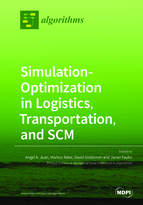Simulation-Optimization in Logistics, Transportation, and SCM
A special issue of Algorithms (ISSN 1999-4893). This special issue belongs to the section "Evolutionary Algorithms and Machine Learning".
Deadline for manuscript submissions: closed (15 November 2020) | Viewed by 40937
Special Issue Editors
Interests: metaheuristics; simulation; machine learning; smart cities
Special Issues, Collections and Topics in MDPI journals
Interests: computer simulation; logistics assistance systems; industrial IT systems; business processes; intralogistics; supply chains; urban last-mile delivery; data farming and data analysis
Special Issues, Collections and Topics in MDPI journals
Interests: simulation output analysis, statistical ranking and selection methods, and medical and humanitarian applications of operations research
Special Issues, Collections and Topics in MDPI journals
Interests: smart cities; transportation; vehicle routing problems; logistics; simheuristics
Special Issues, Collections and Topics in MDPI journals
Special Issue Information
Dear Colleagues,
Transportation, logistics, and supply chain systems and networks constitute one of the pillars of modern economies and societies. From sustainable traffic management in smart cities or air transportation to green and socially responsible logistics practices, many enterprises and governments around the world have to make decisions that affect the efficiency of these complex systems. Typically, optimization algorithms are employed to deal with these challenges, and simulation approaches are utilized when considering scenarios under uncertainty. However, better results might be achieved by hybridizing both optimization algorithms with simulation techniques to deal with real-life transportation, logistics, and SCM challenges, which often are large-scale and NP-hard problems under uncertainty conditions. Hence, simheuristic algorithms (combining metaheuristics with simulation) as well as other simulation-optimization approaches constitute an effective way to support decision makers in such complex scenarios.
This Special Issue aims at presenting a collection of high-quality papers on simulation-optimization in transportation, logistics, and supply chain management. Simulation-optimization algorithms, including simheuristics and simulation-based optimization, and their practical applications in the solving of rich and realistic scenarios under uncertainty are welcome. The Special Issue is open to well-known researchers in these topics. In particular, this Special Issue is strongly connected to the topics covered in the Winter Simulation Conference (WSC) track on logistics, transportation, and SCM, which includes a stream in simheuristic algorithms as well. Extended versions of the best papers presented at the WSC’19 and WSC’20 (as well as at other conferences of similar quality) are also invited.
Prof. Dr. Angel A. Juan
Prof. Dr. Markus Rabe
Prof. Dr. David Goldsman
Prof. Dr. Javier Faulin
Guest Editors
Manuscript Submission Information
Manuscripts should be submitted online at www.mdpi.com by registering and logging in to this website. Once you are registered, click here to go to the submission form. Manuscripts can be submitted until the deadline. All submissions that pass pre-check are peer-reviewed. Accepted papers will be published continuously in the journal (as soon as accepted) and will be listed together on the special issue website. Research articles, review articles as well as short communications are invited. For planned papers, a title and short abstract (about 100 words) can be sent to the Editorial Office for announcement on this website.
Submitted manuscripts should not have been published previously, nor be under consideration for publication elsewhere (except conference proceedings papers). All manuscripts are thoroughly refereed through a single-blind peer-review process. A guide for authors and other relevant information for submission of manuscripts is available on the Instructions for Authors page. Algorithms is an international peer-reviewed open access monthly journal published by MDPI.
Please visit the Instructions for Authors page before submitting a manuscript. The Article Processing Charge (APC) for publication in this open access journal is 1600 CHF (Swiss Francs). Submitted papers should be well formatted and use good English. Authors may use MDPI's English editing service prior to publication or during author revisions.
Keywords
- Simulation
- Heuristics and metaheuristics
- Simheuristics
- Transportation
- Logistics
- Supply chain management
- Smart cities
- Intelligent transportation systems
- Sustainable transportation and logistics
- Simulation-based optimization
- Machine learning
- Learnheuristics
- Biased-randomized algorithms









